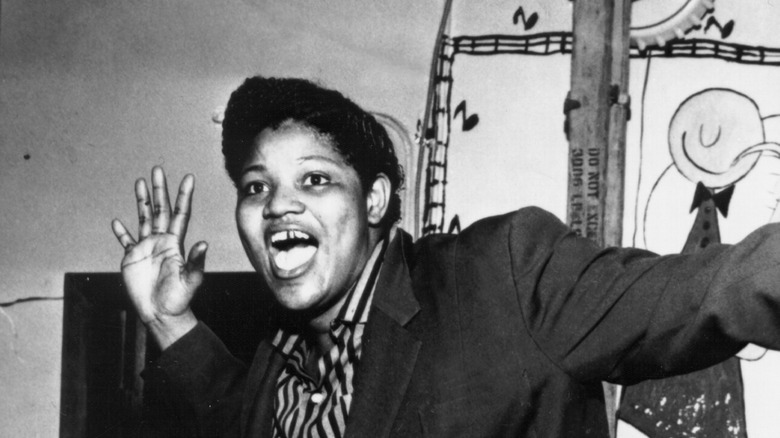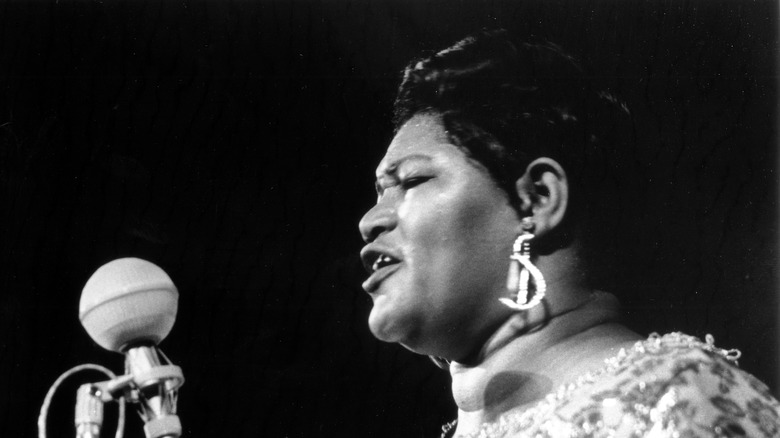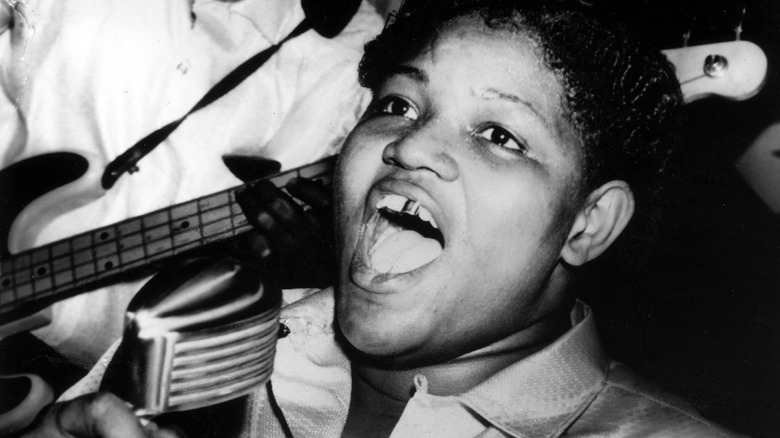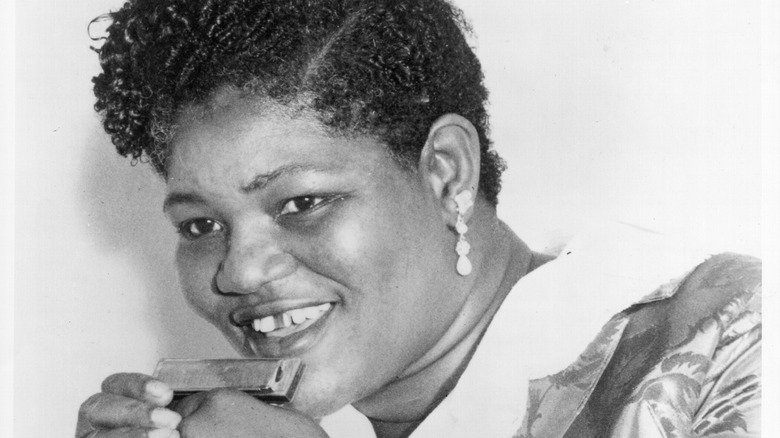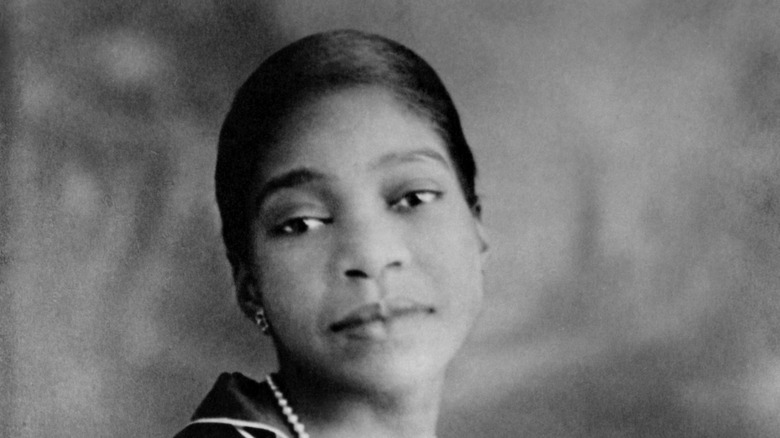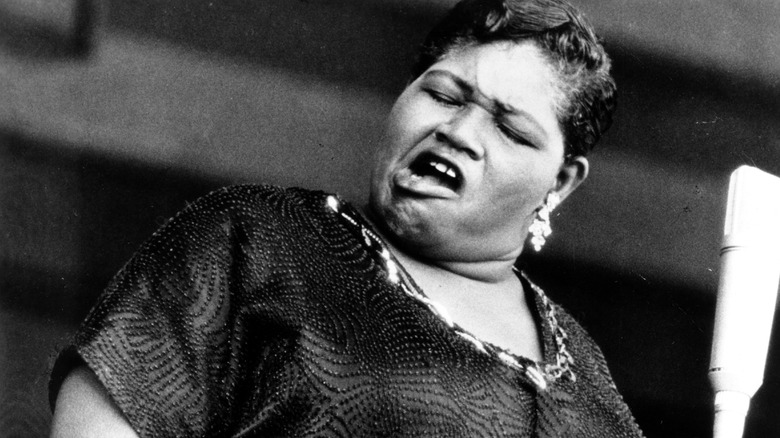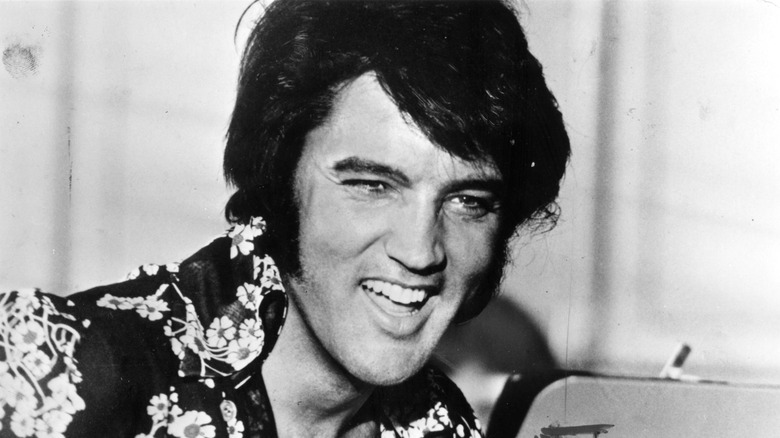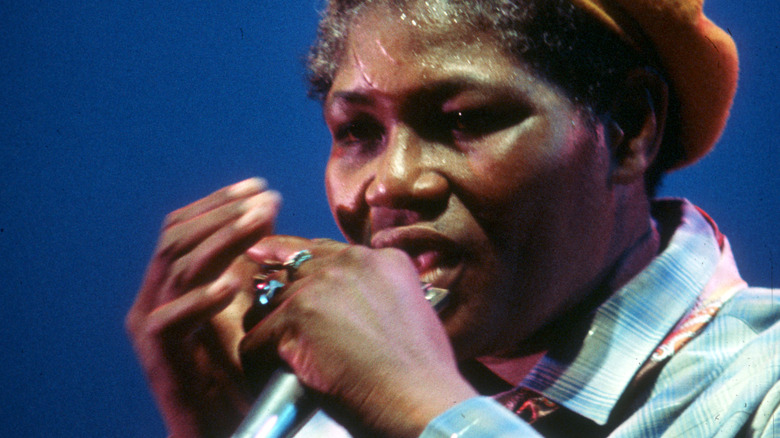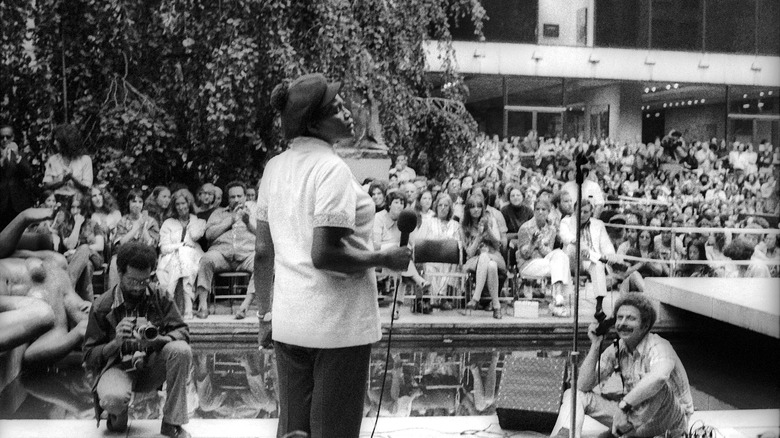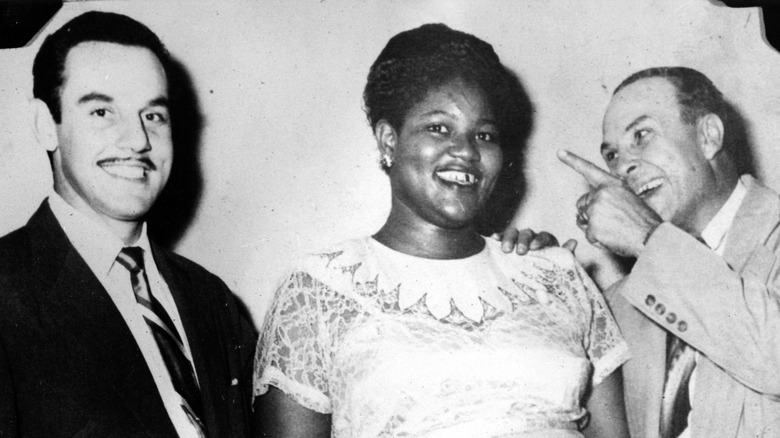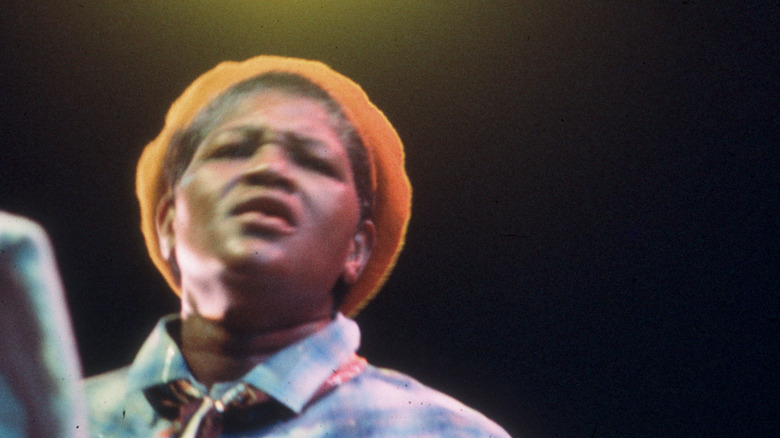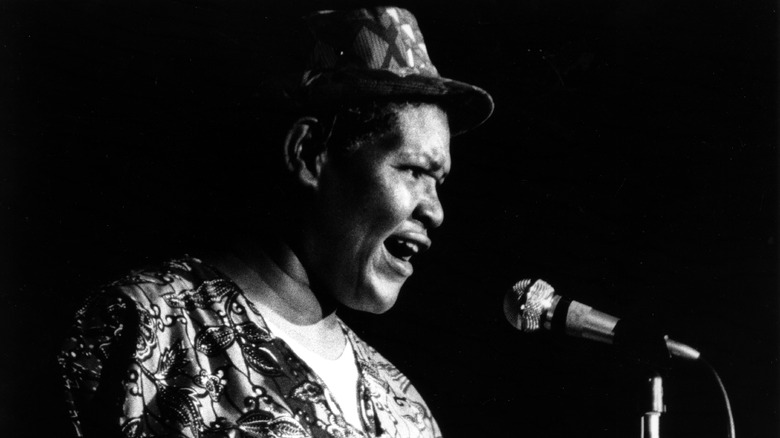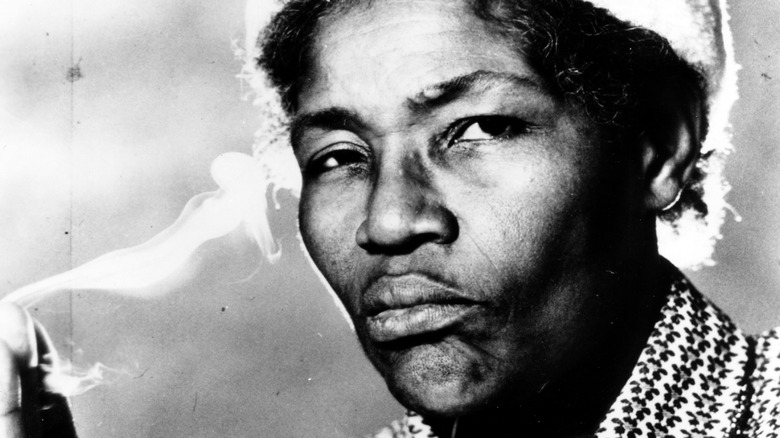The Untold Truth Of Big Mama Thornton
Many people know Big Mama Thornton as that 1950s musician whose songs were made popular by Elvis Presley and Janis Joplin, as Michael Spörke describes in "Big Mama Thornton: The Life and Music." But Thornton's musical journey is a much more complex story and a true rollercoaster from a few points of view. However, one thing remained constant throughout her life: her unmatched vocal power and presence on stage. Musician Ron Thompson summed it up: "She was certainly a big person. She was somebody that you knew was in the room, when she was there. She was a very good person, but she was no joke," he said, grouping her talent with the likes of Muddy Waters, Howlin' Wolf, and Lightnin' Hopkins. "It was intense what she was doing. She was like the real deal."
Thornton herself proudly announced she could sing louder than any microphone, but it wasn't just her voice that was extremely powerful. She was a brave and confident woman who faced huge hurdles like poverty, misogyny, and racism. Her resilience earned her fame and admirers, but her success didn't come without hardship. Here's the untold truth of Big Mama Thornton.
Big Mama Thornton had religious beginnings
Binnie Willie Mae Thornton was born on December 11, 1926, near Montgomery, Alabama, as per Michael Spörke's biography "Big Mama Thornton: The Life and Music." Her father, George W. Thornton, was a Baptist minister, and he was almost two decades older than his wife, Mattie. Thornton had five older siblings and a younger brother, who died shortly after he was born. When she was around 4 years old, the family moved to Troy City, Pike County, also in Alabama. There, Mattie would sing in the church choir and would take her daughter with her.
At first, Thornton didn't do a lot of singing: "We went to church a lot and I sang there sometimes but not especially often." But since she was by her mother's side at the church choir — and her father also worked at the church — Thornton did a lot of listening. It was there that she formed her spectacular musical ear, that would help her learn instruments by ear. When she was 8 years old, she taught herself to play the harmonica just by listening to her older brother, Calliope "Harp" Thornton. If it wasn't for the church, Thornton might not have fallen into a world of music or become a star. As Far Out reports, in 1940, famous gospel performer Diamond Teeth Mary helped her join Sammy Green's Hot Harlem Revue, which paved the road to her fame.
She started work very early
As Michael Spörke reports in "Big Mama Thornton: The Life and Music," Big Mama Thornton had very poor attendance at school because her mother was seriously ill with tuberculosis. Thornton cared for her mother until her death in 1939 — that year, Thornton was 13 but still in the third grade, barely able to read or write. And after losing her mother, Thornton couldn't afford going back to school. She had to get a job and support her family. So she started scrubbing the floors of a local saloon, as per Encyclopedia of Alabama. It wasn't much of a job, but it was at this very tavern where Thornton got the first opportunity to play in front of an audience.
According to Spörke, the saloon had a regular singer who would come in every night, but one night, she got drunk and was unable to perform. That's when Thornton came in and suggested she replace the singer for the night. She knew blues music by heart, and she'd done a bit of singing at the church — the owner decided to give her a try. It's unclear how long she continued singing at the saloon, but from that point on, Thornton started getting noticed by singers and music entrepreneurs. The first big name to notice Thornton was Sammy Green — at aged 14, she left Alabama with Green's show and started traveling the United States (via the Arhoolie Foundation).
She never went to music school
It's always impressive to listen to a great musician play, but it all gets taken up a notch when you learn they're self-taught. Several famous musicians never learned to read music, including Eric Clapton, Jimi Hendrix, Aretha Franklin, and even star filmscore composer Hans Zimmer (via Classic FM). Big Mama Thornton falls into this exact category, and she prided herself on it. In an interview with Ralph Gleason (via "Big Mama Thornton: The Life and Music," by Michael Spörke), she said, "I learned to sing the blues by myself ... My singing comes from experience, my own experience, my own feeling ... I never had no one teach me nothing." Thornton added she was never specially trained since she had to take care of her ailing mother. And in addition to learning the harmonica, she also learned drums simply by observing others. "I can't read music but I know where I'm singing!" she exclaimed.
This was precisely the confident go-getter attitude that helped Thornton achieve greatness in an age of African-American segregation and steep economic decline, as Far Out reports.
Big Mama Thornton's biggest influences
Any musician, self-taught or not, has a few great influences that shape their musical style. So before Big Mama Thornton could influence modern rock, she was influenced by the first generation of Black blues musicians in the United States. The musician quoted by most — including Thornton herself — as her biggest influence is the "Empress of the Blues," Bessie Smith. Thornton commented (via Michael Spörke's "Big Mama Thornton: The Life and Music"), "Back in them yesteryears when I was comin' up, listening to Bessie Smith and all, they sung from their heart and soul and expressed themselves."
Then there's Memphis Minnie, the songwriter, guitarist, and singer who was also hailed as the "Queen of the Blues." As per Far Out Magazine, Thornton's musical style is a clear hats-off to Memphis Minnie. Encyclopedia of Alabama also cites Ma Rainey and Junior Parker as influences Thornton acknowledged. Thornton was still in her teenage years when she was nicknamed "the new Bessie Smith," much to her delight — she had always admired the singer.
People were impressed by her raw power
Every written account of Big Mama Thornton mentions her raw power and big presence on stage. As Far Out reports, musician Jerry Leiber — who went on to co-write Thornton's famous song "Hound Dog" — remembers seeing her play for the first time: "We saw Big Mama, and she knocked me cold. She looked like the biggest, baddest, saltiest chick you would ever see. And she was mean, a 'lady bear,' as they used to call 'em. She must have been 350 pounds, and she had all these scars all over her face."
But her large physical presence was not the most impressive part (even though she would regularly hold the microphone stand airborne while singing, according to Michael Spörke's "Big Mama Thornton"). It was her howls, growls, and impressive musical range, sang with the same amount of power, that left a mark on the musical world. When musician Jimmy Whitherspoon saw Thornton play on stage during the 1980s, she was a frail figure who had difficulty walking. Still, Whitherspoon remembers, "Her voice was still so powerful it made me weak to listen."
She made other musicians famous
Here's where the story takes a tragic turn. In 1952, Big Mama Thornton recorded a song written for her by Jerry Leiber and Mike Stoller, as Far Out reports. The song was called "Hound Dog," and it was arguably Thornton's biggest hit (and Thornton's growl on the tune became a blues staple that would inspire others in the future). According to Encyclopedia of Alabama, "Hound Dog" sold around two million copies. Still, Thornton only received a $500 check for the song. She never got any royalties for it, either. Needless to say, when Elvis Presley covered "Hound Dog" in 1956, he sold 10 million copies and got much more money from it. Leiber was infuriated with Presley's rendition, too: "I have no idea what that rabbit business is all about. The song is not about a dog, it's about a man, a freeloading gigolo" (via Far Out).
Then, in the early 1960s, Thornton recorded a song written by herself, "Ball 'n' Chain." Her label at the time, Bay-Tone Records, didn't release the song until 1968. So when Janis Joplin covered and released the song the same year, Thornton once again received no royalties, as the song's copyright belonged to the label. On top of the financial frustration was the fact that both songs were big hits for Presley and Joplin, propelling them to even greater fame. Thornton remained a lesser-known musical figure, in the shadow of giants who appealed to the white pop music audiences.
She joined a theater group and left home
Big Mama Thornton was 14 years old when Sammy Green's Hot Harlem Revue stopped in her town for a day. After their show, Thornton got an audition and joined their band. The Hot Harlem Revue was a traveling theater group from Atlanta, Georgia, that featured dancers, singers, and comedians, as Thornton told Chris Strachwitz in an interview with the Arhoolie Foundation. As per Michael Spörke's "Big Mama Thornton: The Life and Music," Green was an eclectic entrepreneur who started off by selling popcorn, then became the owner of several brothels, only to move onto theater later in life.
Just before World War II broke out, Thornton left Alabama and headed to Georgia with Sammy Green's Hot Harlem Revue and Diamond Teeth Mary, who had told Thornton about the audition. This is how Thornton began traveling the parts of the U.S. that welcomed Black performers. Dancer Billy Wright recalls, "We played Birmingham every Monday and Tuesday, Montgomery on Wednesday, and Macon on Thursday, then back to Atlanta for Friday and Saturday." During the war, Thornton and the troupe played mostly in Texas, Thornton explained to the Arhoolie Foundation. Thornton stayed with Sammy Green's Hot Harlem Revue for close to a full decade. In 1948, she left the group and settled in Houston, where she would start recording music.
Big Mama Thornton was on-and-off popular
Big Mama Thornton's life was defined by ups and downs when it comes to popularity and financial gain. As Encyclopedia of Alabama reports, after she started performing in Houston, Texas, in 1948, producers Johnny Otis and Don Robey noticed her and invited her to join the Peacock Records Label. The early 1950s were, arguably, Thornton's most successful years. She recorded with Robey, and she would also play at Robey's club, The Bronze Peacock, on a regular basis. Then, she toured the "Chitlin' Circuit" — the clubs and bars whose doors were open to African-American musicians. Thornton's tour peaked with the famous New York Cotton Club, where jazz giants like Duke Ellington found fame (via Britannica).
In 1952, Thornton played with Otis at the Apollo Theater in New York, and the same year, she recorded her hit song "Hound Dog." But toward the end of the decade, Thornton's popularity had declined, having no new contract or even a band, notes the Encyclopedia of Alabama. Then, the mid-1960s brought along a blues revival, this time aimed at a white audience as well: Figures like the Rolling Stones and Bob Dylan stand as strong examples. This is when Janis Joplin discovered Thornton, and around this time, Thornton started her first European tour. In 1968, Thornton played at the Sky River Rock Festival along with Santana and the Grateful Dead. After yet another peak, Thornton's popularity suffered a slow and steady decline until her death in 1984.
Peacock Records
In 1951, Big Mama Thornton signed a five-year contract with Don Robey's Peacock Records Label, after Robey saw her show at the Eldorado Ballroom in Houston (via "Big Mama Thornton: The Life and Music," by Michael Spörke). Within a year, Thornton reached the peak of her stardom. Robey booked her shows throughout the southern U.S. His own club, The Bronze Peacock, had its stage in the center, so everyone could sit close to the live band. This made the venue quite popular, and thousands of people saw Thornton's powerful shows there.
Peacock Records Label became a big deal in itself: As per Encyclopedia of Alabama, the label specialized in gospel and blues music. During the 1950s, it signed several big names, including Johnny Ace and Little Richard. Little Richard actually remembered an interesting detail about Thornton's time there: "Robey was known for beating people up. He would beat everybody up, but Big Mama Thornton. He was scared of her, and she was built like a big bull." Indeed, most accounts picture Robey as a selfish businessman with a short temper. Nevertheless, he put Thornton in contact with Johnny Otis, who Thornton joined for her famous Apollo Theater show in 1952. After her contract with Peacock Records ended, Thornton was left without a job (via the Arhoolie Foundation). "So, I drove on back down through Alabama, Georgia... stopping and seeing old friends because I didn't have anything else to do," she said.
She died broke
The fact that Big Mama Thornton only got $500 for "Big Hound" (but Elvis Presley made much more), as infuriating as it sounds, was not a shock for the African-American community at the time. As Forbes notes, in the 1950s, most Black artists in the U.S. were allowed to record music but not to collect many royalties from it. The Conversation confirms this as a century-old issue. Ray Charles was a pioneer at the end of the decade in negotiating a contract where he owned his masters and later creating his own publishing firm so he could collect royalties, as per Investor's Business Daily — this encouraged other artists to break the pattern and challenge their record labels, notes Smooth R&B 105.7. Sadly, this wasn't the case for Thornton.
Even in her Peacock Records years, Thornton struggled financially, as per "Big Mama Thornton: The Life and Music," by Michael Spörke. Throughout most of her career, she shined shoes as a way to get by, as the shows simply didn't pay enough to ensure the basic necessities of life. Spörke also reports that Thornton was just a teenager when she had a son. But due to her lack of financial stability (or stability of any sort), authorities ended up taking her son away.
Tragically, when Thornton spoke to Chris Strachwitz with the Arhoolie Foundation in her latter years, she confirmed she was quite poor: "I need a job. I need help. Help! So many youngsters are jumping up now, and they forget about the old timers."
She was a musical jack of all trades
Big Mama Thornton could play a plethora of instruments, including drums and harmonica, as per the Encyclopedia of Alabama (and of course, her signature voice, with which she could sing blues, jazz, or rock). As per Michael Spörke's "Big Mama Thornton: The Life and Music," it was Thornton's harmonica that earned the most praise from a stylistic point of view. However, she never got to record herself playing the harmonica during her contract with Peacock Records Label: "All they wanted was for me to just sing."
But after her decline in popularity, Thornton got to play quite a lot of harmonica and drums, while she toured with a few small bands who already had singers, as per Encyclopedia.com. In a way, Thornton reverted to what she used to do with Sammy Green's Hot Harlem Revue: a mix of singing, dancing, drumming, and harmonica, depending on what the band needed. Her musical versatility was what caught Don Robey's eye back in 1948, and it was what saved her musician skin during the later decades of her life.
Alcohol brought her downfall
Big Mama Thornton's strong personality went hand-in-hand with a self-destructive habit: alcohol abuse. As per Encyclopedia.com, Thornton struggled with liver cirrhosis during the last years of her life, as a result of decades-long alcoholism. In the mid-1980s, Thornton had shed some 300 pounds, weighing a mere 90 pounds, according to "She's a Rebel," by Gillian Gaar. She got weaker and weaker — some of her last shows stand as testament, as she had to be walked on and off the stage (via "Big Mama Thornton: The Life and Music," by Michael Spörke). A final heart attack ended a few very long and painful years.
As Gaar reports, on July 25, 1984, Willie Mae Thornton died in a Los Angeles rooming house. She was 57 years old, as per Black Past. Ironically enough, it was after her death that Thornton got recognition. She was also inducted into the Blues Hall of Fame posthumously, as per the Encyclopedia of Alabama, and her song, "Ball and Chain," was included in the Rock & Roll Hall of Fame's "500 Songs That Shaped Rock" (via Infoplease).
If you or anyone you know is struggling with addiction issues, help is available. Visit the Substance Abuse and Mental Health Services Administration website or contact SAMHSA's National Helpline at 1-800-662-HELP (4357).
